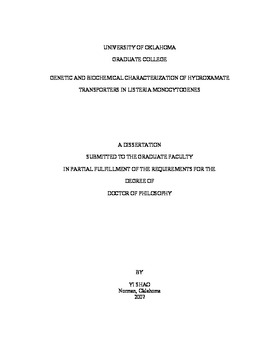| dc.contributor.advisor | Klebba, Phillip E., | en_US |
| dc.contributor.author | Shao, Yi. | en_US |
| dc.date.accessioned | 2013-08-16T12:20:57Z | |
| dc.date.available | 2013-08-16T12:20:57Z | |
| dc.date.issued | 2007 | en_US |
| dc.identifier.uri | https://hdl.handle.net/11244/1284 | |
| dc.description.abstract | Listeria monocytogenes is a Gram-positive bacterial pathogen that can cause severe opportunistic infection in humans and animals, and iron is a virulence determinant in this pathogen. By sequence homologies, the genome of Listeria monocytogenes shows at least 4 potential cell envelope iron uptake systems: at 2.031 Mb (the fur region), 2.184 Mb (the feo region), 2.27 Mb (the srtB region) and 2.499 MB (which we later designated as the hupDGC region). Herein we biochemically determined the relationship of those systems to the mechanisms of listerial iron acquisition. We created systematic chromosomal deletions of genes in each of those loci. Mutations in the fur and hupDGC regions showed defects in the uptake of ferric hydroxamates and hemin/hemoglobin, respectively. The other locus srtB, which showed greatest homology to the isd locus in S. aureus, didn't show any phenotype in terms of iron uptake. In the fur locus, deletion of fhuD (lmo1959) or fhuC(lmo1960 ), which encodes a putative iron-binding lipoprotein and a membrane ATPase of an ABC transporter, severely impaired the uptake of ferrichrome, ferrichrome A and ferrioxamine B, but they didn't show any attenuation of virulence in mouse model. On the other hand, elimination of hupC (lmo2429) created defects in hemin/hemoglobin uptake and reduced infectious virulence in the mouse model system. I further characterized the function of fhuD by cloning the gene in an expression vector and purifying the expressed protein. The fhuD gene encoded a lipoprotein that was important for the utilization of iron (III)-hydroxamates by Listeria monocytogenes. | en_US |
| dc.description.abstract | Full length FhuD (no signal peptide cleavage) showed low expression in E. coli but when the signal peptide was deleted by genetic engineering, the resultant mature FhuD was overexpressed in the cytoplasm. I purified the protein and studied the function of the FhuD protein in greater detail, demonstrating that it binds several different hydroxamates siderophores (with or without iron chelated) with different specificity and affinities, but it did not bind to non-hydroxamate siderophores. Those intrinsic fluorescence measurements reveals the KDs for iron(III)-ferrichrome, iron(III)-desferrioxamine B, iron(III)-ferrichrome A and iron(III)-aerobactin as 306nM, 123 nM, 451 nM and 231 nM, respectively. My data demonstrated that listerial FhuD is specific for ferrioxamine B, but it can recognize and bind other hydroxamate siderophores with less affinity. It absorbed apo-ferrichrome but not to apo-ferrichrome A. To our further surprise, FhuD absorbed to apo-ferrioxamine B with greater affinity than for any other compound tested. The possibility of redundancy in S. aureus and B. subtilis regarding hydroxamate siderophore transport systems but in L. monocytogenes the FhuGBCD permease (lmo1957/1958/1959/1960) that FhuD (lmo1959) is the primary transporter of hydroxamate siderophores. Another, secondary hydroxamate siderophore transport system may exist in L. monocytogenes or another binding lipoprotein may share the same traffic ABC transporter, creating slightly different selectivity, specificity, affinity and transport velocity. | en_US |
| dc.format.extent | xiii, 162 leaves : | en_US |
| dc.subject | Listeria monocytogenes. | en_US |
| dc.subject | Iron Physiological transport. | en_US |
| dc.subject | Chemistry, Biochemistry. | en_US |
| dc.subject | Microbial metabolism. | en_US |
| dc.title | Genetic and biochemical characterization of hydroxamate transporters in Listeria monocytogenes. | en_US |
| dc.type | Thesis | en_US |
| dc.thesis.degree | Ph.D. | en_US |
| dc.thesis.degreeDiscipline | Department of Chemistry and Biochemistry | en_US |
| dc.note | Adviser: Phillip E. Klebba. | en_US |
| dc.note | Source: Dissertation Abstracts International, Volume: 68-12, Section: B, page: 8012. | en_US |
| ou.identifier | (UMI)AAI3291243 | en_US |
| ou.group | College of Arts and Sciences::Department of Chemistry and Biochemistry | |
